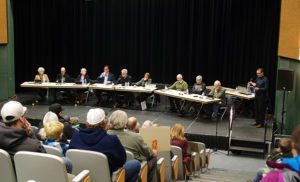Home »

Marysville Benchland dominates OCP hearing
Worries about the industrialization of the Marysville Benchland monopolized a 100-minute long public hearing covering the proposed update to the City of Kimberley’s Official Community Plan (OCP) last night.
A total of 29 residents, from the more than 100 in attendance at McKim Middle School theatre, addressed the hearing, a few more than once, with one common thread expressed: no one is opposed to new industry setting up in town.
 However, the proposed Marysville Benchland location for the establishment of a high tech business (Sullivan Machine Works) on land already zoned industrial does not work for 14 speakers who declared opposition to the project and its inclusion in the OCP.
However, the proposed Marysville Benchland location for the establishment of a high tech business (Sullivan Machine Works) on land already zoned industrial does not work for 14 speakers who declared opposition to the project and its inclusion in the OCP.
Eleven speakers spoke in favour of the proposal and OCP, while another four speakers did not make it clear if they were in favour or opposition.
The natural beauty of the benchland and the view afforded from the edge trail should not be impacted, numerous speakers argued, suggesting alternative locations, including the two small industrial areas already in place, should be utilized.
Other concerns included decreased property values, transportation, parking, noise and dismay over the community being divided over the issue.
“The bigger picture is the community is divided but one thing in common is we all want industry, just not there,” said Marysville resident Sherry Kearns, adding she hasn’t seen “such division” in the 17 years she’s lived in the community.
She pointed out that the Regional District of East Kootenay recently scrapped its proposed OCP for the Jaffray area because of opposition to the plan, and the city could do the same.
Some speakers suggested the city negotiate with Teck to obtain lands on the east side of Jim Ogilvie Way, or incorporate land from outside boundaries to create another more desirable locale for industrial uses.
Resident Greg McCallum said he believes fears of the city fading due to job loss are unfounded.
“I don’t believe our town is dying in any way, shape or form,” he said, later noting the City of Cranbrook has plenty of industrial land and it should remain the location for such activity, while Kimberley retains its current charms.
“I don’t think we have to attract a huge amount of business” as the city is doing fine, he said.
 Other speakers stated they would not have selected Kimberley or their current homes as places to move to or retire had they known the benchland might soon be home to a large industrial operation that would command the view from Marysville.
Other speakers stated they would not have selected Kimberley or their current homes as places to move to or retire had they known the benchland might soon be home to a large industrial operation that would command the view from Marysville.
Those speaking in favour cited the need for clean industry and jobs for the sake of the city’s future.
Business and property owner Michelle Nex warned against setting a precedent that could scare away future potential investors.
“We can’t indiscriminately” dismiss business opportunities, she said. “We must attract industry and business to our city. Seasonal tourism alone cannot support our city,” she said, adding she fears the city becoming “a ghost town. We need to remember we are talking about the land neighbouring the dump.”
Resident Scott Davis stated council needs to consider young kids in its determination moving forward, noting for younger generations to stay in town, jobs are needed.
“We need to diversify. If we have a chance for 10 professional paying jobs in town, it’s a chance we should take,” he said.
Marysville resident Mark Krahn agreed.
“If we do say no, we’ll send out a message to other industries that we are not interested in industry.”
 Kimberley and District Chamber of Commerce manager Mike Guarnery said he sees the benchland issue as a win-win – whereas the Volksmarch trail will be preserved and needed industry will be located nearby.
Kimberley and District Chamber of Commerce manager Mike Guarnery said he sees the benchland issue as a win-win – whereas the Volksmarch trail will be preserved and needed industry will be located nearby.
“We have to trust our council and staff,” he said, noting they will conduct due diligence before allowing anything to proceed.
“This isn’t about smokestacks. Let’s use this (city-owned) land as an opportunity to move forward,” he said.
Property owner Zoe Ferguson said she was shocked to learn the scale of Teck’s (and Cominco’s) past impact on the city’s tax base, and the loss of it, as well about the volume of brownfield land in the city that cannot be utilized.
“I have a giant tax bill and I am looking for a sense of relief. It is light industry and it is not smokestacks,” she said.
The city is undertaking the first comprehensive review of the city OCP since 2005.

City council approved first reading of the proposed OCP Bylaw 2600 December 11, to initiate the formal bylaw review and public hearing process for the updated OCP. Second reading was approved at the January 22.
The primary objectives of the OCP review and update project include: refreshing and confirming the community’s vision for land use and development; developing clear and concise content to guide planning decisions; improving mapping and layout, review development permit areas and guidelines; aligning land use policy with asset management and infrastructure planning; and setting a clear framework for implementation and tracking progress.
A summary of key outcomes and policy directions in the proposed OCP include:
prioritizing infill development and redevelopment in areas with infrastructure capacity; removing proposed southern boundary extension areas; increasing land area designated for industrial and commercial uses to support employment growth, business attraction, and expansion opportunities; increasing land area designated for parks, recreation and open space uses; designating a portion of the city-owned Marysville Benchlands property for future industrial development excluding the perimetre (Volksmarch) trail, hillsides and other portions not suitable for development; Concise and clear content – overall reduction from 121 down to 60 pages, Development Permit guidelines reduced from about 330 to 101 (36 to 15 pages); Simplified land use plan 23 to 6 categories; User-friendly web-based text and maps to improve ease of access and understanding to important planning and land use information; and a set of 25 indicators for tracking and regularly reporting progress and impacts of implementing the plan’s objectives and policies.
Council will likely be handling the next readings of the OCP bylaw at its next regular meeting on Feb. 26.
– Ian Cobb/e-KNOW







